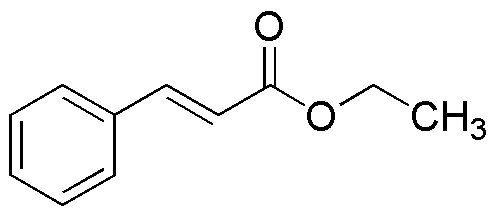Phenethyl cinnamate is widely utilized in research focused on
- Fragrance Industry: This compound is commonly used in perfumes and scented products due to its pleasant aroma, enhancing the overall sensory experience for consumers.
- Food Flavoring: It serves as a flavoring agent in various food products, providing a sweet and fruity taste that appeals to consumers' palates.
- Cosmetics: In skincare and cosmetic formulations, it acts as a fragrance component and may also offer some skin-conditioning properties, making products more appealing.
- Pharmaceuticals: It is explored for its potential therapeutic properties, including anti-inflammatory effects, which can be beneficial in developing new medications.
- Research Applications: In chemical research, it is used as a model compound to study esterification reactions and the behavior of aromatic compounds, aiding in the development of new synthetic methods.
Informations générales
Propriétés
Sécurité et réglementation
Applications
Phenethyl cinnamate is widely utilized in research focused on
- Fragrance Industry: This compound is commonly used in perfumes and scented products due to its pleasant aroma, enhancing the overall sensory experience for consumers.
- Food Flavoring: It serves as a flavoring agent in various food products, providing a sweet and fruity taste that appeals to consumers' palates.
- Cosmetics: In skincare and cosmetic formulations, it acts as a fragrance component and may also offer some skin-conditioning properties, making products more appealing.
- Pharmaceuticals: It is explored for its potential therapeutic properties, including anti-inflammatory effects, which can be beneficial in developing new medications.
- Research Applications: In chemical research, it is used as a model compound to study esterification reactions and the behavior of aromatic compounds, aiding in the development of new synthetic methods.
Documents
Fiches de données de sécurité (FDS)
La FDS fournit des informations de sécurité complètes sur la manipulation, le stockage et l’élimination du produit.
Spécifications du produit (PS)
Le PS fournit une description complète des propriétés du produit, notamment sa composition chimique, son état physique, sa pureté et les exigences de stockage. Il détaille également les plages de qualité acceptables et les applications prévues du produit.
Certificats d'analyse (COA)
Recherchez des certificats d'analyse (COA) en saisissant le numéro de lot du produit. Les numéros de lot et de lot se trouvent sur l'étiquette d'un produit, après les mots « Lot » ou « Lot de fabrication ».
Numéro de catalogue
Numéro de lot/série
Certificats d'origine (COO)
Ce certificat d'exploitation confirme le pays dans lequel le produit a été fabriqué, et détaille également les matériaux et composants utilisés et s'il est issu de sources naturelles, synthétiques ou autres sources spécifiques. Ce certificat peut être requis pour les douanes, le commerce et la conformité réglementaire.
Numéro de catalogue
Numéro de lot/série
Fiches de données de sécurité (FDS)
La FDS fournit des informations de sécurité complètes sur la manipulation, le stockage et l’élimination du produit.
DownloadSpécifications du produit (PS)
Le PS fournit une description complète des propriétés du produit, notamment sa composition chimique, son état physique, sa pureté et les exigences de stockage. Il détaille également les plages de qualité acceptables et les applications prévues du produit.
DownloadCertificats d'analyse (COA)
Recherchez des certificats d'analyse (COA) en saisissant le numéro de lot du produit. Les numéros de lot et de lot se trouvent sur l'étiquette d'un produit, après les mots « Lot » ou « Lot de fabrication ».
Numéro de catalogue
Numéro de lot/série
Certificats d'origine (COO)
Ce certificat d'exploitation confirme le pays dans lequel le produit a été fabriqué, et détaille également les matériaux et composants utilisés et s'il est issu de sources naturelles, synthétiques ou autres sources spécifiques. Ce certificat peut être requis pour les douanes, le commerce et la conformité réglementaire.

